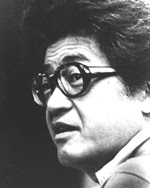The premise is as follows. A school teacher called Niki Junpei has taken a few days off to spend time on his hobby, collecting insects. For that purpose he visits a dune region in a remote part of Japan, far from Tokyo. (The area that immediately comes to mind are the sand dunes of Tottori, also used in the surrealistic photography of Ueda Shoji - although Abe seems to have had scenery from Yamagata Prefecture in mind).

[Tottori sand dunes]
Junpei listens without interest to her story - he thinks it has nothing to do with him, after all he will be leaving the next morning. But when the next day dawns, he discovers that the rope ladder has been removed. He has been trapped. The villagers tell him he must help the widow, as she needs the strength of a man to battle the ever-encroaching sand. Junpei has been caught like an insect.
At first, he rebels. He tries to escape, by various means, but fails to clamber up the steep walls. Another time, he makes it out of the pit, but gets lost in the dunes and is finally caught again. He then takes the widow captive, but that does not make things any better. For now the villagers, who in exchange for the sand used to provide the widow with water, food and other necessities, stop supplying them even with water. Going crazy with thirst in the hot, dusty pit, Junpei is forced to release her.
Eventually, Junpei adjusts himself to his captivity. He even becomes the widow's lover and more or less resigns himself to his fate. But he still tries to capture a crow to use the bird as messenger, to let the world know of his fate. Through the trap, he then discovers a way to draw water from the damp subsoil and becomes absorbed in his new task of engineering. He is elated to find that he can actually improve the environment in which he is forced to live.
At the end of the book Junpei gets the chance to escape, when the widow who is pregnant with his child, is suddenly taken to a hospital because of a problem with her pregnancy. The villagers forget to remove the rope ladder, but now Junpei does not want to leave anymore.

[Abe Kobo]
I first read The Woman in the Dunes in the early eighties, when I studied in Kyoto. I bought it as a Tuttle paperback at the local Maruzen, a copy that still looks beautiful - Tuttle used good-quality paper - and has the added interest of containing illustrations by Abe Machi, the wife of the author. Back in Holland, in the mid-eighties, a Dutch translation was published, and I wrote a review for one of the major dailies. I would only see the film much later, after coming back to Tokyo and buying the DVD.
In the sixties, seventies and eighties, Abe Kobo was considered as one of the best contemporary Japanese authors. In one interesting aspect he resembles Murakami Haruki: both authors aim their work at a cosmopolitan public and do not try to be particularly "Japanese." A typical (originally left-wing) intellectual, a modernist who liked to experiment, Abe was very fashionable in his own time.
Thanks to that popularity, Abe has been well served by translators. Besides The Woman in the Dunes these are: Around the Curve (some of his early stories); The Woman in the Dunes; The Face of Another; The Ruined Map; The Ark Sakura; The Box Man; Secret Rendezvous; Kangeroo Notebook; Inter Ice Age 4; and plays as The Man who Turned into a Stick.
The Woman in the Dunes is in all respects a perfect novel. The ideas, the setting, the story and the way it is told, the implications for the human condition, everything is in perfect balance.

[Film poster showing Kishida Keiko]
In the title of this post I have added the name of Teshigahara Hiroshi - so indelibly has the great prize-winning film by the Sogetsu-ikebana grand master lodged itself in my head. The film follows the book faithfully, it was adapted by Abe himself. Teshigahara was a great avant-gardist active as painter, sculptor, garden designer, tea house architect, theater director and of course ikebana meister. He also made twenty films, of which eight were full-length features. Four of these were made with Abe, the first one, Pitfall, based on a script by the author, the other three on novels by him (the others are The Face of Another and The Ruined Map). As film, too, The Woman in the Dunes is a perfect masterwork. For the protagonists, Teshigahara found Okada Eiji and Kishida Keiko, and both melted completely into their roles. The music was composed by another avant-gardist, brilliant "classical" composer Takemitsu Toru. Takemitsu liked to write for the film and worked with almost all famous directors of the sixties.

[Teshigahara Hiroshi]
Of course, the visuals are also spectacular, even although this is a black-and-white film. Teshigahara returns time and again to shots of the shifting sands, and the abstract compositions of sand and dunes become a fearful presence in themselves, the third protagonist of the film. While you watch the film, you feel the itch of imaginary grains of sand, and when you get up afterwards, you are almost tempted to brush the sand from your clothes!
Novel and film are two complimentary masterworks. If you have not enjoyed them yet, you have a great pleasure waiting for you.